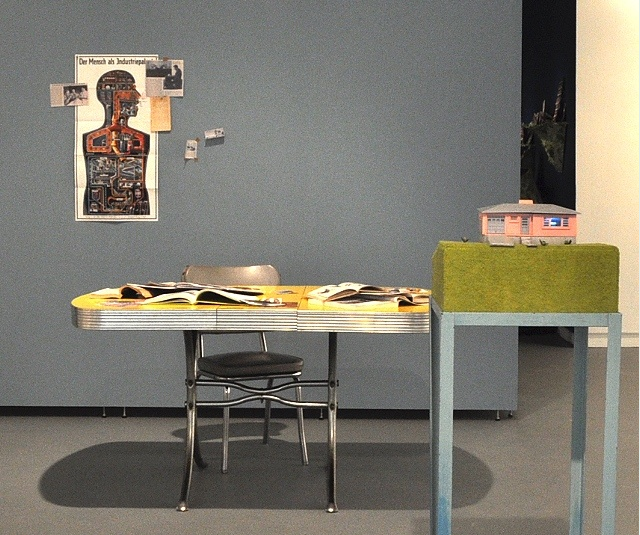MFA Year 2 - Artist Talk

“Manchine” Sarah McNeil 2011
Artist Statement
Through my artwork I investigate, experiment, document and promote the invasion into the divergent landscapes of real everyday, and imaginary fabricated, worlds. More specifically the overlapping regions between these worlds, essentially the remaining areas not claimed by either. Inspired by the expeditions of early Explorers who wished to discover uncharted territory, my artistic quest is to enter into this gray area and to blur the boundaries of these two spaces, in order to increase the square footage of a new hybrid region. In this area the domination of either world is not apparent, yet evidence of both worlds exists. It is in this new landscape where my artwork to collectively resides, my pioneering spirit and escapist desires are satisfied, and I trespass to become the maker of philosophical toys and psychological machines.
Philosophical toys, originally popularized in the 19th century, were tabletop, optical toys, which demonstrated scientific and mathematical phenomena to both adults and children, while also providing amusement. They were intended to provoke thinking towards the world we live in and it is precisely this experimental examination, rather than the scientific explanation, of the world, that I seek to create.
I also operate under the belief that machines are not unbiased instruments, but rather are devices created from our deepest fears and desires. Evidence for this is overwhelming and can be examined in everything from the obvious pleasure seeking products of the sex doll and beauty/vanity industry and in simulated virtual realities, to fear based inventions for sanitation, and safety/security based products for our households. Moral panic and personal liberation/satisfaction are among the most powerful tools in the psychological machine Inventor’s toolbox.
I am interested in the intense psychological forces of fear and desire, and have found humor to be the binding thread between the two. My machines and toys incorporate the absurd as they explore the strangeness of our own psyches.
NIGHT BLINDNESS VS. NIGHT VISION GOGGLES
This installation falls into the philosophical toy category and is comprised of three dream theatres and a stop motion animation video projection. The dream theatres are based on Victorian-era toy theatres and small puppet stage designs and are titled: The Discovery of Night Blindness, The Orchard of Unusual Possibilities, and In Pursuit of Night Vision Goggles and are all inhabited by the fears and desires of the puppet’s dream world.
The Discovery of Night Blindness dream theatre is also the stage for the stop motion animation video projection. It is the bedroom of the puppet and is the only interior set of the three. It is the location of the dreaming, as implied in the video, yet the dream theatre is shown without the puppet. The bed is unmade and an army of eyes are emerging from under the bed and exiting out the door, it appears she (the puppet) has fled the room.
The eyes make appearances in all of the sets. For example: in The Orchard of Unusual Possibilities they act as the fallen fruit from the pink blossoming orchard trees. The orchard also has paper cut out puppets, which hide beneath the limbs of the trees. The paper figures clearly do not belong in this three dimensional world, yet appear comfortable in this habitat. The title originating from Russian writer Ludmilla Petrushevskaya’s dream like surrealist fiction, and like in Ludmilla’s world, this is also a secondary landscape full of unpredictable discoveries.
The last dream theatre In Pursuit of Night Vision Goggles is the site of a bike crash, and it is here we find out that the puppet, without her sleep mask, is eyeless. She is grasping a porcelain and glass mask of eyes, indicating that she has obtained her night vision goggles. Eyes hidden throughout the landscape recognize that vision was always around her, even when she could not see.
MANCHINE
Manchine is an interactive sculpture with an embedded stop motion video animation and is a continuation into my exploration of into the concepts of philosophical toys, and psychological machines, this being a little of both. This is also a cautionary tale to be careful with what you desire.
In Manchine, a bodybuilder becomes so concerned with his physique that his body actually turns into a mechanical apparatus, or rather, a manchine. The perfect suburban pink ranch is neglected, which is seen in the both the exterior of the house and in the landscape, where dandelions are allowed to grow in the lawn, and all the while the manchine cyclically continues on with his leg lifts in the basement.
The interior of the house is activated when the viewer shades a photoresistor hidden in a dandelion. When shaded the front room light turns on. Mirroring occurs on two scales, first on a small “o” train model scale inside the front room of the pink ranch house, and then is replicated on a human scale beyond the sculpture. Viewers are then allowed to “enter” the house via the human scale environment to see the compulsion of the body builder.
On a yellow table, human scale, we find a collection of photos, and magazine newspaper cuts outs on various systems of the human body and the relation ship between the systems of machines. Books on body building, medical and scientific texts little the table top. A notebook is opened to show the daily workout log and it is obviously not possible for any man to do without serious mechanical alterations.